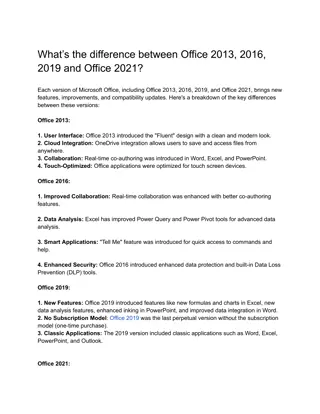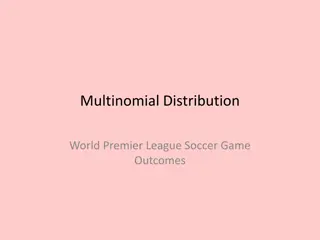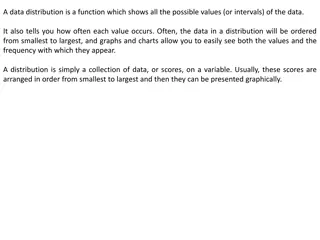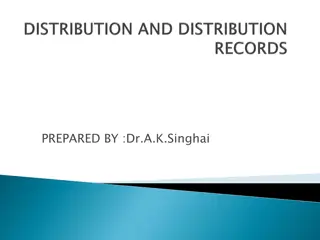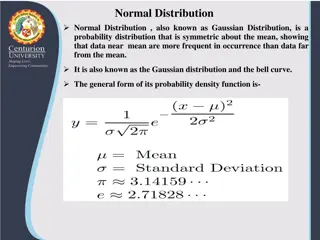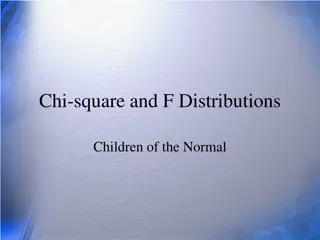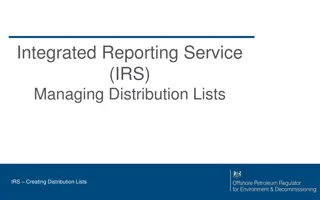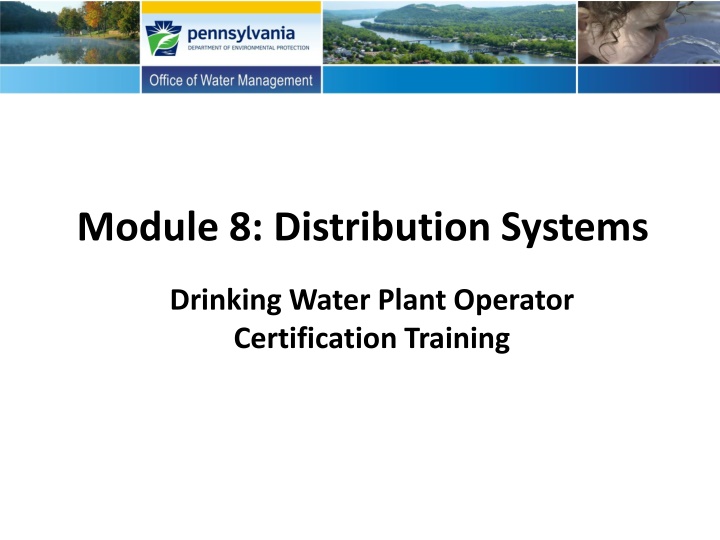
Operator Certification Training in Distribution Systems for Water Plants
"Explore the modules covering operator certification, distribution networks, storage, water quality monitoring, and more. Learn about regulations, key components, network layout, customer service connections, and storage facilities in drinking water plants."
Download Presentation

Please find below an Image/Link to download the presentation.
The content on the website is provided AS IS for your information and personal use only. It may not be sold, licensed, or shared on other websites without obtaining consent from the author. If you encounter any issues during the download, it is possible that the publisher has removed the file from their server.
You are allowed to download the files provided on this website for personal or commercial use, subject to the condition that they are used lawfully. All files are the property of their respective owners.
The content on the website is provided AS IS for your information and personal use only. It may not be sold, licensed, or shared on other websites without obtaining consent from the author.
E N D
Presentation Transcript
Module 8: Distribution Systems Drinking Water Plant Operator Certification Training
Topical Outline Unit 1 Introduction to Operator Certification Unit 2 Distribution Networks Unit 3 Distribution Storage Unit 4 Water Quality and Monitoring 2
Unit 1 Intro to Operator Certification Learning Objectives Introduce distribution operator certification regulations. Discuss operator certification continuing education requirements. Discuss intended results of certification regulations. Identify the use of process control decisions and standard operating procedures. 3
Operator Certification Act Water and Wastewater Operator Certification Program Regulations Establishes standards for operator certification, recertification, certification renewal and security training; Certification Board has the authority to give certification approval. 4
Unit 1 Wrap-Up Key Points on Page 1-4 Exercise on Page 1-5 5
Unit 2 Distribution Networks Learning Objectives Identify the key components of a distribution network and describe the primary purpose or function of each component. Define the relationship among pressure, head, and hydraulic grade line. Outline the relationship between distribution system customers demands and their effects on distribution system performance. 6
Distribution System Layout Distribution Network Storage Facilities Customers Treatment Facility Pipes Valves Transmission Main Source of Supply Pumps (reservoir, streams, wells, etc.) Meters Hydrants 7
Typical Customer Service Connection Service lines are used to convey water from the distribution network to individual system customers. A corporation stop or shut-off valve is typically located at the connection of the service line and distribution pipe. Meter/ backflow preventer Customer property Customer Curb box Service line Service line Corporation stop Curb stop 8
Storage Facilities Help offset fluctuations in system demands Help minimize fluctuations in system pressure Elevated tanks are used to provide pressure in distribution systems Provide reserve volumes of water to help meet fire flow needs Provide an emergency source of supply for the system 9
Valves Isolation Valves The most commonly used isolation valve is the gate valve. Control Valves Altitude valves are types of flow control valves that control flow in and out of storage facilities based on water level. Air Release Valves Used to eliminate air from a distribution network or to allow air into a distribution network. 10
Typical Isolation Valve Locations Pipes Roads Valves 11
Valve Operation # of turns = (Diameter of the valve (in inches) x 3) + 3 Valve Size Number of Turns 14 27 38 53 4 inch 8 inch 12 inch 16inch 12
Types of Meters Displacement Velocity Compound Electronic Proportional 13
Types of Fire Hydrants Dry-barrel hydrants Include a shut-off valve at the base to prevent damage from freezing. Wet-barrel hydrants Have a shut-off valve at the outlet and can only be used in areas where freezing is not a concern. 14
Fire Hydrant Coding Color GPM Rating Blue 1500 or more Very Good Flows Green 1000-1499 Good for residential Orange 500-999 Marginally adequate Red Below 500 Inadequate Primarily, fire fighters need to know how much water is available from the closest hydrant so that they may select the appropriate size hose lines for the size and complexity of the fire, but not select lines which would exceed the capacity of the hydrant and thus be ineffective. This information is known as "available flow." 15
Backflow Prevention To prevent potential contaminants from being introduced to the distribution network by the reverse flow of water from a source of questionable water quality. Physical air gap Vacuum Breaker Double check valve assembly Reduced pressure zone device 16
Hydraulic Grade Line Hydraulic grade line Pressure head 17
What would be the pressure at the bottom of each tank? 125 ft 18
Example 2.2 Pressure Head Calculation How many feet of water would be in a tank if the pressure gauge at the base of the tank read 15 psi? ft = 2.31 ft x 15 psi 1 psi = (2.31) (15) = 35 Feet 19
Example 2.3 Pressure Head Calculation What would the pressure head in psi be on a fire hydrant if a pressure gauge on that fire hydrant read 258 feet? psi = 1 psi x 258 ft = 111.7 psi 2.31 ft 20
Example 2.4 Pressure Head Calculation What is the pressure (in psi) at a point 12 feet below the surface? psi = 1 psi x 12 ft = 5.2 psi 2.31 ft 21
Hydraulic Grade Line Hydraulic grade line Pressure head Figure 2.18 - Hydraulic Grade Line 22
Energy Loss Hydraulic grade line Energy loss 23
Friction Losses Water Main Flow Turbulence The degree of pipe roughness is called the C-Factor. 24
Customer Types Residential Commercial Industrial Other commonly used customer category types include institutional (schools, hospitals, etc.), bulk (service to another water utility), and municipal (municipal buildings and facilities). 25
Diurnal Demand Curve 2 1.5 1 0.5 0 0 4 8 12 16 20 24 Time of Day 26
Pressures and Flows Normal pressures range from: a minimum of approximately 35 psi maximum of approximately 100 psi. The minimum pressure allowed in a distribution system is 20 psi. When pressures drop below 20 psi, a system could experience backflow conditions 27
Routine Maintenance of Distribution Networks Pump Maintenance Valve Maintenance Meter Testing and Maintenance Fire Hydrant Maintenance Inspection and Monitoring 28
Pipeline Maintenance Program Leak Detection Main Break Repair and Replacement Water Main Replacement 29
Unit 2 Wrap-Up Key Points on Page 2-33 Unit 2 Exercise on 2-34 30
Unit 3 Distribution Storage Learning Objectives List the three primary functions and identify the four types of distribution storage facilities. Calculate the volume of water in a storage facility and define the components of distribution system storage volume allocation. 31
Purpose of Distribution Storage Equalize Demands and Pressures Minimize Fluctuations In System Pressure Fire Protection Emergency Supply 32
Types of Storage Facilities 1. Clear well 2. Elevated 3. Ground Level 4. Stand Pipe 5. Hydropneumatic 33
Storage Volume and Water Level V = Length x Width x Height V = .785 x Diameter2 x Height Don t forget, answers will be in cubic feet. If you need gallons, you need to multiply by 7.48 to convert. 34
Example 3.1 Volume Calculation A rectangular ground level storage facility is 100 feet long by 50 feet wide. The water level in the tank (measured from the bottom of the tank) is 10 feet. What is the volume (in gallons) of water in the tank? V = (l) x (w) x (h), where h is the height of water in the tank V = 100 ft x 50 ft x 10 ft V = 50,000 cubic feet There are 7.48 gallons in a cubic foot. Thus, V = 50,000 cubic feet x 7.48 gallons/cubic foot V = 374,000 gallons 35
Example 3.2 Volume Calculation An elevated tank has a diameter of 50 feet. The water level in the tank is 20 feet. What is the volume of water in the tank? V = (0.785) x (Dia)2 x H V = (0.785) x (50)2 x 20 V = 0.785 x 2500 x 20 = 39,250 cubic feet V = 39,250 ft 3 x 7.48 = 293,590 gallons 36
Example 3.3 Volume Calculation How many gallons of water are in a 400 foot section of main that has an 8 inch diameter? First step: Convert 8 inch to feet Feet 8 in = 0.67 feet 12 in Second step: Plug into volume formula Vol = (0.785) x (diameter)2 x (length) = (0.785) x (0.67 feet)2 x 400 feet = 141 ft3 Third step: Convert ft3 to gallons Gallons = 141 ft3 x 7.48 = 1,055 gallons 37
Example 3.4 Volume Calculation The diameter of a tank is 60 feet. Without refilling of the tank, in one day, the water depth dropped from 25 feet to 21 feet, how many gallons of water were used that day? Height = 25 ft 21 ft = 4 ft V = (0.785) x (diameter)2 x (height) V = (0.785) x (60 ft)2 x (4 ft) = 11,304 ft3 Convert ft3 to gallons Gallons = 11,304 ft3 x 7.48 = 84,554 gallons 38
Useable Storage The useable storage is the total volume of water in a storage facility that can provide minimum required pressures to the highest elevation customers who are served by the facility. Equalization Storage Fire Storage Emergency Storage 39
Purpose of Maintenance Storage facilities require routine maintenance, including routine inspections, to ensure proper operation and identify replacement and repair needs. Painting Corrosion Control Water Quality 40
Unit 3 Wrap Up Key Points Page 3-11 Exercise on Page 3-12 41
Unit 4 Water Quality and Monitoring Learning Objectives Identify the three types of distribution system water quality issues. Describe the purpose of disinfection and chlorine residual in the distribution system. 42
Purpose of Disinfection The use of chlorination is quoted to have a tremendous boon in the safeguarding of public health all over the world and is probably the most important and efficient sanitary measure of protection ever introduced . 43
Disinfection Chemicals Pure chlorine (Cl2) is a poisonous, acidic gas that is heavier than air. When injected into water, it forms the following reaction: Cl2 + H2O Chlorine Water HOCl + HCl Hypochlorous Acid Hydrochloric Acid 44
Three Types of Chlorine Gas Chlorine Calcium Hypochlorite Sodium Hypochlorite 45
Breakpoint Chlorination Breakpoint Chlorination residual (mg/L) Free chlorine 2 Breakpoint 1.5 1 0.5 0 0 0.6 1.2 1.8 2.4 3 3.6 Chlorine dosage (mg/L) 46
Example 4.1 Dosage Calculation The chlorine residual is 0.7 mg/l, and the demand is 0.5 mg/l. What is the dose? Dose = demand + residual = 0.7 + 0.5 = 1.2 mg/l 47
Example 4.2 Dosage Calculation The chlorine dose is 2.1 mg/l, and the demand is 0.9 mg/l. What is the residual? Rearrange = Chlorine Residual = Chlorine Dosage Chlorine Demand So, 2.1 - 0.9 = 1.2 mg/l 48
Disinfection of New Mains and Storage Facilities Contamination Prevention Flushing Disinfection Post-Disinfection 49
Example 4.3 Dosage Calculation A system has replaced 200 feet of 8 inch water main. They are going to use 50 mg/l of chlorine for 24 hours to disinfect the line. How many pounds of 65% calcium hypochlorite are required? Feet 8 in = 0.67 feet 12 in Vol = (0.785) x (diameter)2 x (length) = (0.785) x (0.67 feet)2 x 200 feet = 70 ft3 Gallons = 141 ft3 x 7.48 = 527 gallons 527 gal = 0.0005MGD 1,000,000 gal 0.2 = 0.3 pounds 0.65 50




